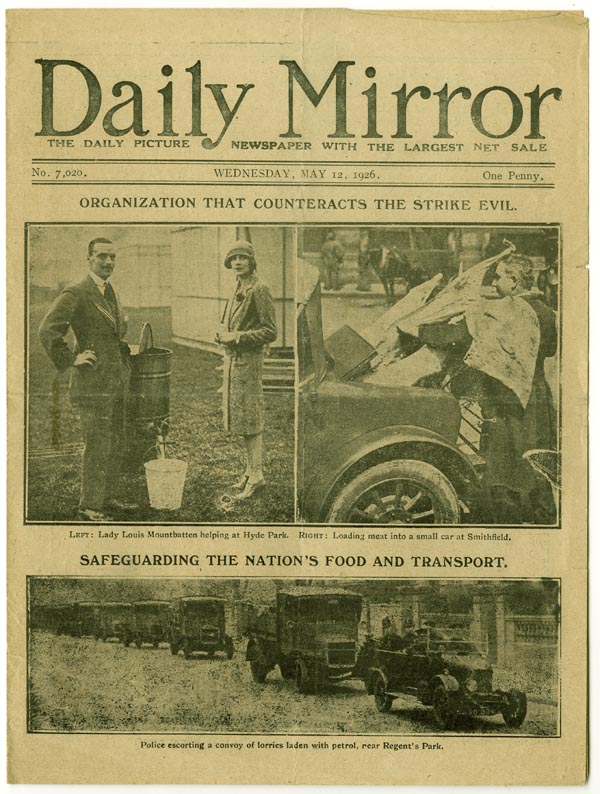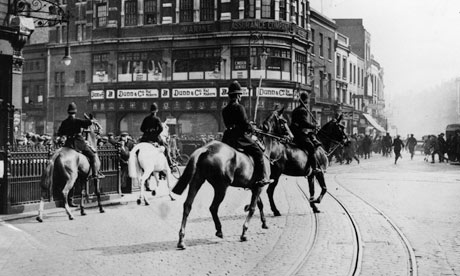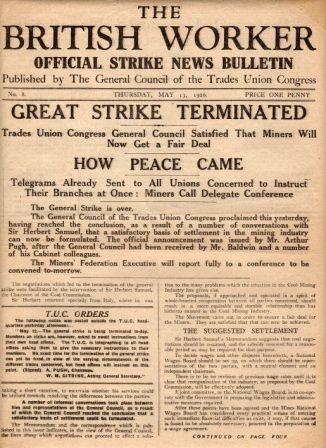by Pete Goddard and Atul Hatwal
It’s somehow fitting that the fuse for the general strike was lit at the Daily Mail.
The government was still engaged in half-hearted negotiations with the unions when, on Sunday 2nd May 1926 the print compositors at the Mail refused to set an inflammatory editorial, entitled “For King and Country.” Although the companion piece, “Compositing print causes cancer” probably didn’t help either.
Seeing an opportunity to kick things off whilst still blaming the unions, the government summarily walked out of the talks muttering about threats to freedom of speech.
The unions thought, “Walk out will you? We’ll show you a thing or two about walking out.”
The next day letters went out to union members up and down the country and on Tuesday 4th May the whistle blew.
”Everybody out!”
The general strike had begun.
Around 1.5 million to 2 million workers took part in the strike. People downed tools all across the country.
Then, frequently, different people across the country picked those tools up again.
Approximately 300,000 volunteers had joined the overwhelmingly middle class and right-wing Organisation for Maintenance of Supplies. Their task was to help keep the country running during the period of the strike in a sort of extended “working class” themed fancy dress party.

The general strike’s PR team knew it had an uphill battle when even the Mirror started calling the strike "evil"
At the same time, with the print setters on strike, someone had to provide the British public with a replacement for their daily sports news, Sudoku and political misinformation. And who had enough spare time to moonlight over hot metal at a time of enormous national economic crisis? The chancellor of the exchequer, of course. Winston Churchill was put in charge of producing the government’s British Gazette.
This was a promotional freesheet on a national scale. Up to 2 million copies a day went out with government news, government views and a coupon for a free day as a bus driver for every reader.

Never the most visual of papers, The British Gazette included on Page 3 a 1,000 word description of a topless model
It was also a useful distraction for the bellicose chancellor. He could play at being Citizen Kane for a change, instead of his normal preferred game of soldiers
The TUC attempted some media plurality by producing its own paper, the British Worker. They managed to produce between 250,000 and 400,000 copies per day. This output was quite limited due in no small part to Churchill, who had requisitioned all the newsprint. See, you don’t need to own all the papers to own the media, you just need all the ink – are you reading Rupert?
This lopsided propaganda battle was typical of the strike in general. The TUC and supporters made a brave effort, but the government had all the resources.
This reality was grimly apparent to members of the trade union general council. Ernest Bevin and Jimmy Thomas, leaders of the TGWU and railwaymen, were deeply uneasy. Regardless of the brave speeches, they were acutely aware that their members, the ones who had elected them and that they were meant to represent, were basically supporting a miners’ strike.
Workers’ solidarity is a fine thing, but it wasn’t really clear how the miners could possibly win.
On the futility of the miners’ position, even Bevin privately agreed with his bête noire, Ramsay Macdonald, who wrote in his diary,
“…we are up against the hard face of impossibility as miners cannot budge from “not a shilling & not a minute…Strike cannot settle purely economic problem of bankruptcy of industry. Were it to be ‘won’ industry remains bankrupt.”
The only potential long term solution for mining was nationalisation. But it wasn’t even on the table as this was a dispute between miners and mine owners.
The jangling nerves of the union leaders were strummed on May 6th when the first fatality of the strike occurred: a volunteer bus driver was forced off the road and died. Stories about sporadic outbreaks of violence also started to filter through. The Guardian reported on trouble in Leeds,
“The trouble began when several thousand strikers attacked one of the emergency tramcars with lumps of coal taken from a passing lorry, a number of windows in the tram-car being smashed and passengers having narrow escapes. “
Coal was now both figuratively and literally a weapon in the ongoing dispute. It was all getting too much for the trade union general council.
On the 7th May, a TUC negotiating team began secret discussions with Herbert Samuel, author of the rejected royal commission report into the mining industry, on how to end the strike. No-one invited the miners, possibly because their “not a penny off…” routine wasn’t exactly a great way to open talks.
Frantically, the negotiators searched for a solution.
Stanley Baldwin had one. “You guys give up, then we’ll talk.”
After four fruitless days of non-negotiation, the unions began to wonder if Baldwin’s solution was the only one available. The miners, who by now had got wind of the secret talks, were furious. They had no intention of giving up.
But they were alone in that resolve.
On the 11th May, just nine days after the strike was declared, Walter Citrine, TUC general secretary announced that nearly everybody would go back to work.
Nearly everybody. The still-determined miners said, “Thanks for your support guys, but we’re staying out. Leave that banner when you go, we could use that.”
On 12 May 1926, the TUC General Council met with Stanley Baldwin to announce their decision to call off the strike.
They had one last demand – that the government give some assurance that the strikers would not be victimised after they returned to work.
They didn’t even get that.
One member of the government, Lord Birkenhead, later wrote that the TUC’s surrender was “so humiliating that some instinctive breeding made one unwilling even to look at them.”
Stanley Baldwin at least tried to sound magnanimous in victory. “The occasion calls neither for malice nor for recrimination, nor for triumph,” he said, slightly undermined by the sound of party poppers in the background.
“Oh, is it over already? Did we miss it?” said Ramsay Macdonald and most of the Labour party, peering from under a blanket in Westminster.
Labour’s leaders had stayed out of the whole affair. With their deep-seated fear of union action alienating the voters, it was the best they could offer .
But they couldn’t stay silent forever. Ramsay Macdonald finally found his voice and set a precedent for generations of senior politicians in a tight spot: he attacked the BBC.
The Beeb had given the prime minister a slot on the new-fangled wireless to explain the end of the strike. Labour and Macdonald had asked for a right to reply and been told to write to Points of View like everybody else.
Quite what Macdonald would have said, after keeping so studiously quiet during the strike itself, nobody knows.
The unions certainly didn’t. Ernest Bevin was particularly scathing. He declared Macdonald, “Wantonly guilty of stabbing us in the back at the moment when we had the whole force of capital unleashed against us,” conveniently forgetting about his misgivings about the whole thing and role as a member of the TU general council in ending the strike.
As for the miners, they limped on alone.
In 1921, when they had last gone on strike, they held out despite the failed attempt at a general strike remembered as Black Friday.
In 1926 they did it again. The miners stayed out on strike for months.
But there is a limit to how long even the most determined of workers can endure. Poverty and hunger bit deep until, in November, they too were forced to go back to work with no concessions.
The general strike had failed.
Pete and Atul are not historians
Tags: Atul Hatwal, British Gazette, British Worker, general strike, Labour history uncut, Pete Goddard, Walter Citrine











Informative and hilarious – thank you for this!
just waiting for the Comic Strip version to come out …. there’s trouble down at the mill …